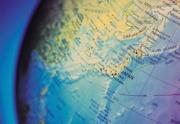
Picture is (C) copyright to wa-pedia
The origins of the Japanese people is not entirely clear yet. It is common for Japanese people to think that Japan is not part of Asia since it is an island, cut off from the continent. This tells a lot about how they see themselves in relation to their neighbours. But in spite of what the Japanese may think of themselves, they do not have extraterrestrial origins, and are indeed related to several peoples in Asia.
During the last Ice Age, which ended approximately 15,000 years ago, Japan was connected to the continent through several land bridges, notably one linking the Ryukyu Islands to Taiwan and Kyushu, one linking Kyushu to the Korean peninsula, and another one connecting Hokkaido to Sakhalin and the Siberian mainland. In fact, the Philippines and Indonesia were also connected to the Asian mainland. This allowed migrations from China and Austronesia towards Japan, about 35,000 years ago. These were the ancestors of the modern Ryukyuans (Okinawans), and the first inhabitants of all Japan.
The Ainu came from Siberia and settled in Hokkaido and Honshu some 15,000 years ago, just before the water levels started rising again. Nowadays the Ryukuyans, the Ainus and the Japanese are considered three ethnically separate groups.
54% of Japanese men belong to haplogroup O, and more precisely to the subgroups O3 and O2b. Both of them could be of Han Chinese or Korean origin. A negligible percentage of the Japanese are O1 or O2a, two lineages that trace their roots among southern Chinese or south-east Asian people.
Y-DNA haplogroup D2, making up 36% of the Japanese male lineages, is interesting because it is only found in Japan. Its closest relatives are scattered around very specific regions of Asia : the Andaman Islands (between India and Myanmar), Indonesia (only a small minority), Southwest China (mostly among the Qiang ethnic group), Mongolia (also a small minority) and Tibet. Haplogroup D is thought to have originated in East Africa some 50,000 years before present. The first carriers of the gene would have migrated along the coasts of the Indian Ocean, through Indonesia, and gone up to Japan, South-East Siberia, then moved inland to Mongolia, with the last part of the group continuing as far as Tibet. However, whereas the Japanese belong to haplogroup D2, Tibetans are part of the completely separate D3a, the Qiang of D1, and the Andaman Islanders of D*. It means that their most recent common ancestors goes back tens of thousands of years. In other words the genetic gap between these ethnic groups is immense, despite false appearances of belonging to a common haplogroup
The 3% of haplogroups N may be of Siberian or Chinese origin. Haplogroup C3, representing also 3% of the population, is typical of the Mongols and Siberians. It might have come with the Ainu through Sakhalin island and Hokkaido, or along with the Yayoi farmers from Korea. C3 is indeed found at both extremities of the country but is rare in central Japan, suggesting two separate entries.
In conclusion, approximately 43% modern Japanese men carry a Y-chromosome of Jomon origin. The highest proportions of Y-DNA haplogroup C and D is found in northern Japan (over 60%) and the lowest in Western Japan (25%). This is concordant with the history of Japan; the Yayoi people of Sino-Korean origins having settled first and most heavily in Kyushu and Chūgoku, in Western Japan.
[Click here to read full article]

























